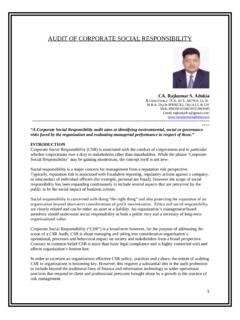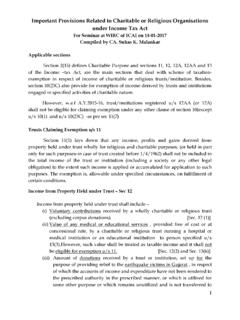Transcription of LAWS GOVERNING FORMATION AND …
1 1 LAWS GOVERNING FORMATION AND administration OF charitable ORGANISATIONS IN INDIA CONTENTS 1. Introduction 2. Evolution and Growth of charitable Organisations in India 3. Meaning of charitable organisation 4. Laws GOVERNING charitable Organisations in India 5. FORMATION and Registration of the various forms of charitable Organisations I. Public charitable Trust under the State Trusts Act II. Section 25 Company under the Companies Act 1956 III. Society under the Societies Registration Act 1860 6. Multi-State Societies Registration Bill 2012 7. Reporting requirements for a charitable organisation 8. Overview of provisions of Bombay Public Trust Act, 1950 2 9. Trust Deed 10. Foreign Contributions to charitable Organisations 11. Religious and charitable Endowments 12.
2 Authorities regulating charitable Organisations 13. Taxation aspects of charitable Organisations 14. Direct Tax Code Bill and charitable Organisations 15. Professional Opportunities In the Charity Sector 16. Laws GOVERNING charitable Organisations in other Countries 17. Useful Websites _____ 1. INTRODUCTION India has an ancient history of society based on the concept of philanthrophy. Vedas, a large body of texts originating in ancient India are the oldest scriptures of Hinduism. The Rig Veda, one out of the four Vedas, refers to some elements of collective social entrepreneurship which manifested in the form of charity as a duty and responsibility of a conscious human being. During the reign of the Mauryas and Guptas (4th century BC to 5th century AD) and even later, a strong village community based on collective entrepreneurship and social collectiveness was in existence across the country.
3 These practices of philanthrophy and a strong and collective community life transformed into the modern concept of social capital. The word "charity" entered the English language through the Old French word "charit " which was derived from the Latin word "caritas". Originally in Latin the word caritas 3 meant preciousness, dearness, high price. From this, in Christian theology, caritas became the standard Latin translation for the Greek word agape, meaning an unlimited loving-kindness to all others, such as the love of God. Agape was not primarily about good works and giving to the poor, although in English the word charity has steadily acquired this as its primary meaning, wherein it was first used in Old French at least since the year 1200 Charity is giving voluntarily to those in need.
4 It covers the giving of both money, and of the self through service to the needy. Charity is defined as - relief of the poor, education, medical relief, and the advancement of any other object of general public utility not involving the carrying on of any activity for profit. The term is also used to denote an institution or organization, which helps those in need. 2. EVOLUTION AND GROWTH OF charitable ORGANISATIONS IN INDIA Though the roots of charity are to be found in religious belief and practice, charitable trusts and voluntary organizations are India s secular and institutional manifestation. India has a long history of civil society. Voluntary organizations were active in cultural promotion, education, health, and natural disaster relief as early as the medieval era.
5 Religious organizations also took up work to help the poor to improve their condition. Towards the end of the 19th century the corporate community in India also began setting up organizations dedicated to the welfare and development of the underprivileged and a large number of Corporate Trusts and Societies came into existence. 4 During the 19th and early 20th century these voluntary organizations received legal recognition as the Government enacted various laws such as the Societies Registration Act of 1860, The Religious Endowments Act of 1863, The Indian Trusts Act of 1882 and the charitable Endowments Act of 1890. Such enactments gave public recognition to the intention of the founders and extended the protection of the law to their income and property, however these enactments were rather mild and did not impose strong regulatory controls.
6 The British Government later added two more legislations the charitable and Religious Trusts Act, 1920 and (ii) the Trade Unions Act, 1926. The Income Tax had been introduced in 1860, and in 1922, the government granted 50% tax exemption to individuals on donations for charitable purposes. The Government of independent India continued and extended the tax concessions given earlier only to individuals, to companies making charitable contributions. The Income Tax Act of 1961 further broadened the definition of charitable purpose. Section 2(15) of the Act defines the expression charitable purpose . All charitable organizations may exist as non-profit companies, societies or trusts. However, structure or management is not the essence of the charitable organization. It is the objectives, which distinguish a charitable organization from a business organization.
7 3. MEANING OF charitable organisation charitable organization is an organization which has an objective of charitable purpose. Trusts, foundations, unincorporated associations and in some jurisdictions specific types of companies, may be established for a charitable purpose or may acquire such purpose after establishment. charitable organisations are non-profit organizations; 5 however, not all non-profit organizations are charitable organizations. Some charitable organizations may be established by companies as part of tax planning strategies. The primary function of a charitable organisation is to give benefit to the public by performing worthy causes that helps the public at large. Also all the operations performed by those organizations are legal and their policy goes in tune with the general public policy.
8 charitable organisations usually have an active way to raise funds through a campaign or conducting programmes. Its functions can range from helping others in times of disaster, giving financial aid, medical services, public works and conducting human right activities. They generally function as a welfare organisation and work for the improvement of the society through their charitable function. Definition of charitable Purpose Public charitable trusts, by definition, must be created for the benefit of the public. Societies likewise may be registered for charitable purposes. Section 25 companies are formed for the limited purposes of "promoting commerce, art, science, religion, charity or any other useful object." In law, the concept of " charitable purpose has a meaning which is not quite the same as in normal language.
9 According to Section 2(15) of the Income Tax Act, 1961, charitable purposes include "relief of the poor, education, medical relief, and the advancement of any other object of 6 general public utility." Finance ( ) Act, 2009 added the "preservation of environment (including watersheds, forests, and wildlife) and preservation of monuments or places or objects of artistic or historic interest" to the list of charitable purposes. Finance Act, 2008 limited the definition of " charitable purpose," by stating that if the "advancement of any other object of general public utility" involves undertaking any trade, commerce, or business activities, or rendering any related service for a fee or any other condition (irrespective of use, application, or retention of income arising from such activities), it will not be considered a " charitable purpose.
10 " The Finance Act 2010, retrospectively effective from April 1, 2009, provided some relief by exempting the aggregate value of receipts from such activities up to one million rupees. Organizations established for and running programs for relief of poverty, education, and medical relief are not affected by the amendments of 2009 or 2010. Section 2(15) defines the expression charitable purpose in an inclusive manner. The aforesaid definition is not exhaustive and, therefore, purposes similar to the purposes mentioned in the aforesaid definition will also constitute charitable purposes. Further, the words any other object of general public utility are of wide import. However, the object should not be of utility for only a few persons. According to Section 9(1) of the Bombay Public Trusts Act, 1950, charitable purpose includes: 1) relief of poverty or distress 2) education 3) medical relief 3A) provision for facilities for recreation or other leisure time occupation (including assistance for such provision), if the facilities are provided in the interest of social welfare and public benefit 4) the advancement of any other object of general public utility, but does not include a purpose which relates exclusively to religious teaching or worship.











